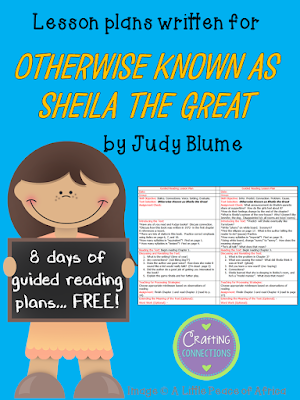This is a two-part blog post!
My primary purpose for writing this blog post is to share another set of guided reading lesson plans with you! Again, these aren't fancy, but they are lessons plans that worked for me. I wrote these plans a few years back when I was reading the book Otherwise Known as Sheila the Great by Judy Blume with a small group of fourth grade students. If you happen to have multiple copies of this Level R book available, I'd love to be able to share these lesson plans with you, and save you from having to write your own plans. I know how time-consuming it is to write guided reading lesson plans each week! (Amazon affiliate link follows.)
My students and I really enjoyed this book. One of the reasons I enjoyed this book is because there are multiple times in this book that the 1972 copyright date is obvious, and it leads to some interesting discussions. As you will see if you download the lesson plans, the copyright date comes into play already in the first chapter when Judy Blume references a record. Later in the book, she mentions a "milk door" and a "mimeograph machine". My favorite way to explain these outdated concepts to students is to simply grab my iPad, go to google images, type in the phrase, and then show them the photograph and explain how it worked "back in the old days".
If you have a Level R guided reading group and access to multiple copies of this Otherwise Known as Sheila the Great, feel free to click on the image and download the PDF version of the lesson plans!
(If you'd like to see the other free guided reading lesson plans I have available, click on the links below.)
Because of Winn-Dixie (Level R)
Shiloh (Level R)
Who Stole the Wizard of Oz? (Level P)
Flat Stanley (Level M)
The Get Rich Quick Club (Level U)
My secondary purpose for writing this blog post is to invite you to check out my new YouTube video. This was created by the amazingly talented Kayse Morris! I thoroughly enjoyed working with Kayse on this project- her enthusiasm is positively contagious! I think she did a wonderful job, and would highly recommend her to anyone who is thinking about making a similar video.





















